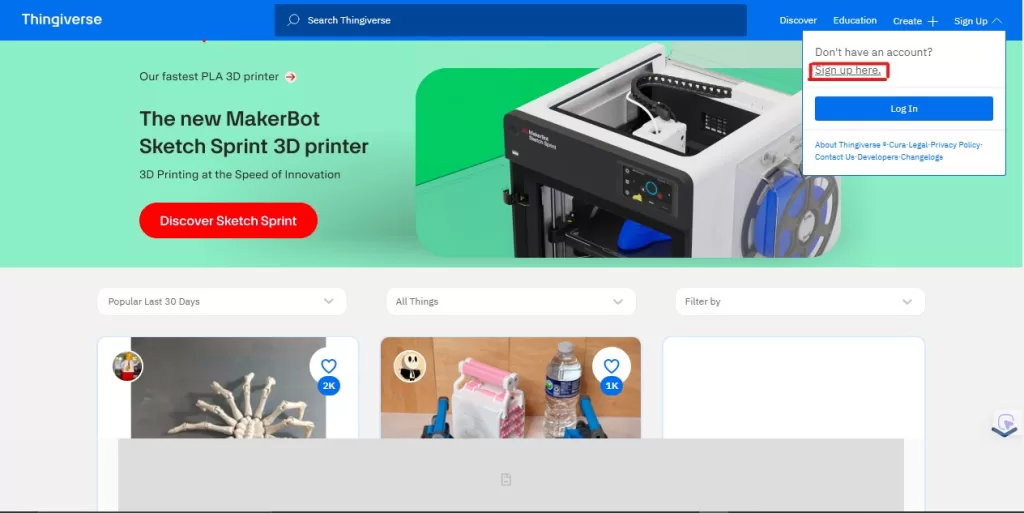Ever stared at your 3D printer, wondering what to create next? With 3D printing becoming more accessible than ever, many makers find themselves stuck in a creative rut, unsure where to find inspiring projects worth printing.
The frustration only grows when you scroll through countless websites, wasting hours searching for reliable 3D models. And even when you find something interesting, there’s no guarantee it’ll print successfully – leading to wasted time, material, and enthusiasm.
Enter Thingiverse, the world’s leading platform for 3D models. This collection of creative designs has transformed how makers approach 3D printing, offering everything from practical household fixes to stunning artistic creations. Whether you’re a beginner or an experienced maker, navigating Thingiverse effectively can unlock endless possibilities for your 3D printing journey.
In this guide, we’ll show you exactly how to start finding and printing awesome 3D models from Thingiverse.
Table of Contents
What is Thingiverse?

Think of Thingiverse as the YouTube of 3D printing files – a vibrant, community-powered platform where creators from around the globe share their 3D models freely. Launched in 2008 by MakerBot Industries, it has grown into the world’s largest collection of downloadable 3D printing designs, with millions of creators contributing everything from practical household solutions to outstanding artistic sculptures.
What makes Thingiverse truly special is its diverse library of 3D models. Need a replacement part for your broken kitchen gadget? There’s probably a model for that. Looking for custom gaming miniatures? You’ll find thousands. From educational tools and architectural models to cosplay props and custom jewelry, the platform spans virtually every imaginable category.
The heart of Thingiverse beats through its community’s “remix culture,” where makers build upon each other’s work, sharing improvements and variations. When someone downloads and prints your design or remixes it into something new, you’re not just sharing files – you’re contributing to a global movement of open-source creativity in the 3D printing world.
Getting started with Thingiverse is straightforward. While you can browse 3D models without an account, creating one unlocks the full potential of the platform.

Simply click “Sign Up,” choose a username that reflects your maker spirit, and you’re ready to dive in.
Pro tip: completing your profile with your interests and printer details helps you connect with like-minded creators and find more relevant designs.


The real magic happens in the search bar and categories. Looking for something specific? Use the search function with filters like “Most Popular” or “Newest First” to narrow down options.

Or explore curated categories – from “Household” to “Art” – to discover unexpected gems.
But here’s the secret to finding the best 3D models: pay attention to the community signals. Look for designs with high “Makes” counts (showing they’ve been successfully printed), detailed comments discussing print settings, and multiple remixes (indicating an active community around the model). The “Like” count and time-tested downloads are your reliable quality indicators.


Want a quick shortcut? Sort by “Popular Last 30 Days” to see what’s currently trending in the Thingiverse community. Your next successful print might just be waiting there.
Downloading and Preparing 3D Models
Ready to turn that awesome Thingiverse find into reality? Downloading models is as easy as clicking the big blue “Download All Files” button on any design page.

But here’s what experienced makers know: always check the “Thing Files” section first. Some models come with multiple versions or specific parts, and you might not need everything.
Plus, smart creators often include pre-supported versions or files optimized for different printer types – a real time-saver.
Before you hit “print,” though, you’ll need to prepare your 3D models in a slicer – think of it as the translator between Thingiverse and your printer. Popular free options like Cura, PrusaSlicer, or OrcaSlicer can turn those .STL files into printer-ready instructions.
Here’s a crucial tip: read the model’s description carefully. Creators often share their tested print settings, including orientation, support recommendations, and infill percentages.

Running into issues? Common problems like models showing as non-manifold (holes in the mesh) can usually be fixed with free tools like Meshmixer before slicing.
Taking time to properly prepare your model is the difference between a great print and a failed one. When in doubt, start with the model creator’s recommended settings – they’ve likely done the testing for you.
Conclusion
Thingiverse isn’t just a website – it’s your gateway to the incredible world of 3D printing possibilities. From your first download to becoming a regular contributor, this platform demonstrates how a passionate community can transform digital files into physical innovations that make our lives better, more creative, and more fun.
Whether you’re looking for practical solutions, artistic inspirations, or educational projects, Thingiverse’s vast library of 3D models has something for every maker. Don’t be afraid to experiment with different designs, share your experiences, and even remix others’ work.
The beauty of the 3D printing community lies in its collaborative spirit and endless creativity. Each time you download, print, or share a model, you’re participating in a global movement of makers who believe in the power of open-source innovation.
So turn on that printer, explore Thingiverse’s countless models, and join the thousands of creators who are shaping the future of making.
